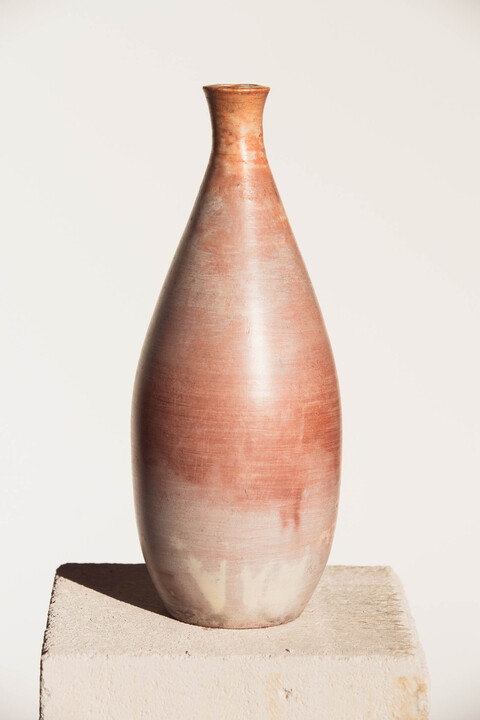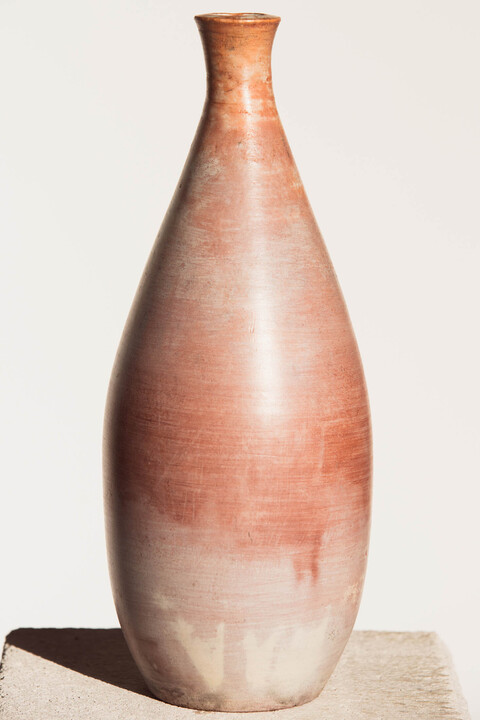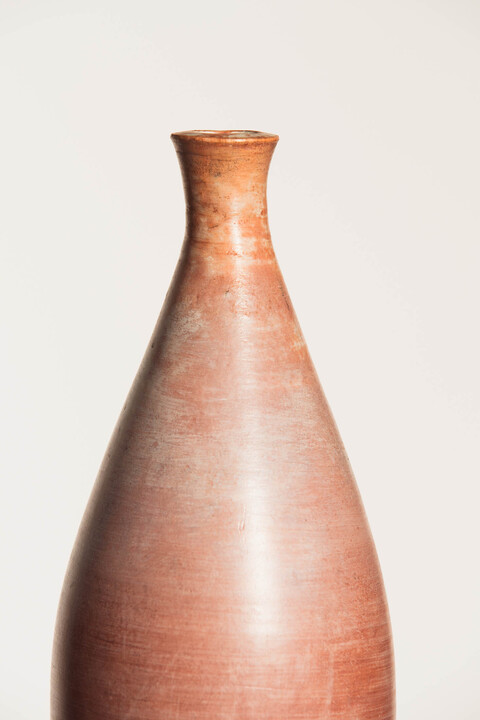- ← back
- → Shop
- → Ceramics
- → Ferric #4
Ferric pottery is an experimental firing technique that harnesses the reactive nature of metallic salts to create ethereal, organic surface patterns. This method is a low-fire process, often done in an atmospheric kiln or open firing, where ferric chloride and other metal solutions are applied to the bisque-fired piece before it is exposed to intense heat.
As the vessel heats up, the metal salts react with the surface, leaving behind unpredictable fiery oranges, deep rusts, smoky blacks, and delicate metallic veining. The results are reminiscent of weathered landscapes, cosmic formations, or even ink dispersing in water—each piece is a singular moment captured in clay.
Ferric firing is often combined with sagger firing, where the pottery is nestled in organic materials like seaweed, sawdust, or copper wire, adding another layer of natural variation. Unlike traditional glazes, these pieces remain porous, their patterns formed by vapor, fire, and the unpredictable chemistry of the firing process.
The beauty of ferric pottery lies in its raw spontaneity—no two pieces can ever be replicated, making each work a true alchemical creation of earth, fire, and metal.
As the vessel heats up, the metal salts react with the surface, leaving behind unpredictable fiery oranges, deep rusts, smoky blacks, and delicate metallic veining. The results are reminiscent of weathered landscapes, cosmic formations, or even ink dispersing in water—each piece is a singular moment captured in clay.
Ferric firing is often combined with sagger firing, where the pottery is nestled in organic materials like seaweed, sawdust, or copper wire, adding another layer of natural variation. Unlike traditional glazes, these pieces remain porous, their patterns formed by vapor, fire, and the unpredictable chemistry of the firing process.
The beauty of ferric pottery lies in its raw spontaneity—no two pieces can ever be replicated, making each work a true alchemical creation of earth, fire, and metal.
Ferric #4
1 Available
Description
Ferric pottery is an experimental firing technique that harnesses the reactive nature of metallic salts to create ethereal, organic surface patterns. This method is a low-fire process, often done in an atmospheric kiln or open firing, where ferric chloride and other metal solutions are applied to the bisque-fired piece before it is exposed to intense heat.
As the vessel heats up, the metal salts react with the surface, leaving behind unpredictable fiery oranges, deep rusts, smoky blacks, and delicate metallic veining. The results are reminiscent of weathered landscapes, cosmic formations, or even ink dispersing in water—each piece is a singular moment captured in clay.
Ferric firing is often combined with sagger firing, where the pottery is nestled in organic materials like seaweed, sawdust, or copper wire, adding another layer of natural variation. Unlike traditional glazes, these pieces remain porous, their patterns formed by vapor, fire, and the unpredictable chemistry of the firing process.
The beauty of ferric pottery lies in its raw spontaneity—no two pieces can ever be replicated, making each work a true alchemical creation of earth, fire, and metal.
As the vessel heats up, the metal salts react with the surface, leaving behind unpredictable fiery oranges, deep rusts, smoky blacks, and delicate metallic veining. The results are reminiscent of weathered landscapes, cosmic formations, or even ink dispersing in water—each piece is a singular moment captured in clay.
Ferric firing is often combined with sagger firing, where the pottery is nestled in organic materials like seaweed, sawdust, or copper wire, adding another layer of natural variation. Unlike traditional glazes, these pieces remain porous, their patterns formed by vapor, fire, and the unpredictable chemistry of the firing process.
The beauty of ferric pottery lies in its raw spontaneity—no two pieces can ever be replicated, making each work a true alchemical creation of earth, fire, and metal.
Ferric pottery is an experimental firing technique that harnesses the reactive nature of metallic salts to create ethereal, organic surface patterns. This method is a low-fire process, often done in an atmospheric kiln or open firing, where ferric chloride and other metal solutions are applied to the bisque-fired piece before it is exposed to intense heat.
As the vessel heats up, the metal salts react with the surface, leaving behind unpredictable fiery oranges, deep rusts, smoky blacks, and delicate metallic veining. The results are reminiscent of weathered landscapes, cosmic formations, or even ink dispersing in water—each piece is a singular moment captured in clay.
Ferric firing is often combined with sagger firing, where the pottery is nestled in organic materials like seaweed, sawdust, or copper wire, adding another layer of natural variation. Unlike traditional glazes, these pieces remain porous, their patterns formed by vapor, fire, and the unpredictable chemistry of the firing process.
The beauty of ferric pottery lies in its raw spontaneity—no two pieces can ever be replicated, making each work a true alchemical creation of earth, fire, and metal.
As the vessel heats up, the metal salts react with the surface, leaving behind unpredictable fiery oranges, deep rusts, smoky blacks, and delicate metallic veining. The results are reminiscent of weathered landscapes, cosmic formations, or even ink dispersing in water—each piece is a singular moment captured in clay.
Ferric firing is often combined with sagger firing, where the pottery is nestled in organic materials like seaweed, sawdust, or copper wire, adding another layer of natural variation. Unlike traditional glazes, these pieces remain porous, their patterns formed by vapor, fire, and the unpredictable chemistry of the firing process.
The beauty of ferric pottery lies in its raw spontaneity—no two pieces can ever be replicated, making each work a true alchemical creation of earth, fire, and metal.
Ferric #4
1 Available
Description
Ferric pottery is an experimental firing technique that harnesses the reactive nature of metallic salts to create ethereal, organic surface patterns. This method is a low-fire process, often done in an atmospheric kiln or open firing, where ferric chloride and other metal solutions are applied to the bisque-fired piece before it is exposed to intense heat.
As the vessel heats up, the metal salts react with the surface, leaving behind unpredictable fiery oranges, deep rusts, smoky blacks, and delicate metallic veining. The results are reminiscent of weathered landscapes, cosmic formations, or even ink dispersing in water—each piece is a singular moment captured in clay.
Ferric firing is often combined with sagger firing, where the pottery is nestled in organic materials like seaweed, sawdust, or copper wire, adding another layer of natural variation. Unlike traditional glazes, these pieces remain porous, their patterns formed by vapor, fire, and the unpredictable chemistry of the firing process.
The beauty of ferric pottery lies in its raw spontaneity—no two pieces can ever be replicated, making each work a true alchemical creation of earth, fire, and metal.
As the vessel heats up, the metal salts react with the surface, leaving behind unpredictable fiery oranges, deep rusts, smoky blacks, and delicate metallic veining. The results are reminiscent of weathered landscapes, cosmic formations, or even ink dispersing in water—each piece is a singular moment captured in clay.
Ferric firing is often combined with sagger firing, where the pottery is nestled in organic materials like seaweed, sawdust, or copper wire, adding another layer of natural variation. Unlike traditional glazes, these pieces remain porous, their patterns formed by vapor, fire, and the unpredictable chemistry of the firing process.
The beauty of ferric pottery lies in its raw spontaneity—no two pieces can ever be replicated, making each work a true alchemical creation of earth, fire, and metal.












